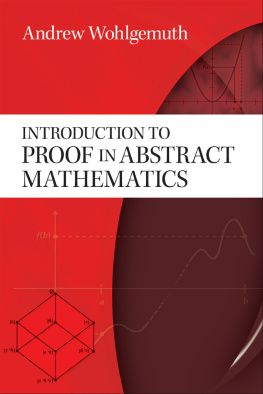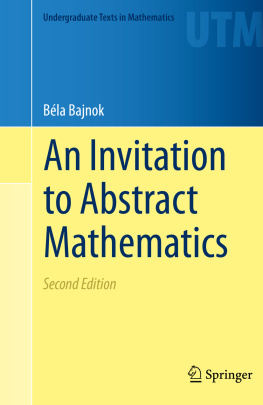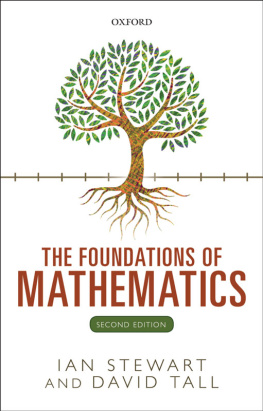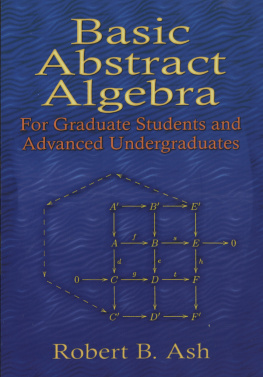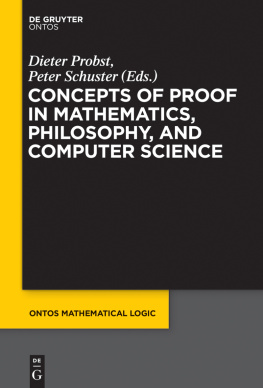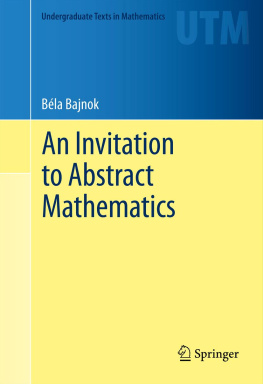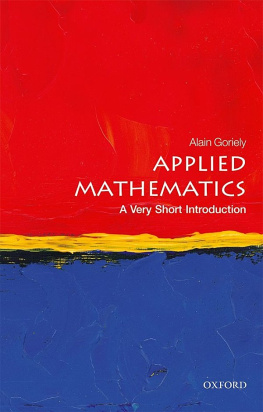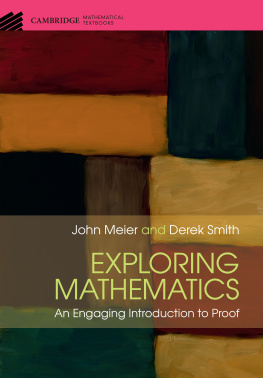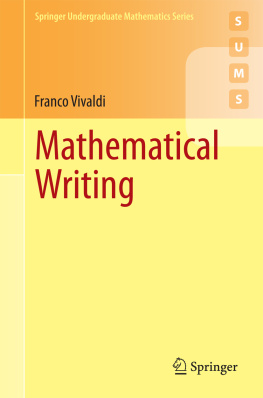Wohlgemuth - Introduction to proof in abstract mathematics
Here you can read online Wohlgemuth - Introduction to proof in abstract mathematics full text of the book (entire story) in english for free. Download pdf and epub, get meaning, cover and reviews about this ebook. City: Mineola, N.Y., year: 2011, publisher: Dover Publications, genre: Children. Description of the work, (preface) as well as reviews are available. Best literature library LitArk.com created for fans of good reading and offers a wide selection of genres:
Romance novel
Science fiction
Adventure
Detective
Science
History
Home and family
Prose
Art
Politics
Computer
Non-fiction
Religion
Business
Children
Humor
Choose a favorite category and find really read worthwhile books. Enjoy immersion in the world of imagination, feel the emotions of the characters or learn something new for yourself, make an fascinating discovery.
- Book:Introduction to proof in abstract mathematics
- Author:
- Publisher:Dover Publications
- Genre:
- Year:2011
- City:Mineola, N.Y.
- Rating:3 / 5
- Favourites:Add to favourites
- Your mark:
- 60
- 1
- 2
- 3
- 4
- 5
Introduction to proof in abstract mathematics: summary, description and annotation
We offer to read an annotation, description, summary or preface (depends on what the author of the book "Introduction to proof in abstract mathematics" wrote himself). If you haven't found the necessary information about the book — write in the comments, we will try to find it.
Wohlgemuth: author's other books
Who wrote Introduction to proof in abstract mathematics? Find out the surname, the name of the author of the book and a list of all author's works by series.
Introduction to proof in abstract mathematics — read online for free the complete book (whole text) full work
Below is the text of the book, divided by pages. System saving the place of the last page read, allows you to conveniently read the book "Introduction to proof in abstract mathematics" online for free, without having to search again every time where you left off. Put a bookmark, and you can go to the page where you finished reading at any time.
Font size:
Interval:
Bookmark:
Introduction to Proof in Abstract Mathematics
Andrew Wohlgemuth
University of Maine
Dover Publications, Inc.
Mineola, New York
Copyright
Copyright 1990, 2011 by Andrew Wohlgemuth
All rights reserved.
Bibliographical Note
This Dover edition, first published in 2011, is an unabridged republication of the work originally published in 1990 by Saunders College Publishing, Philadelphia. The author has provided a new Introduction for this edition.
Library of Congress Cataloging-in-Publication Data
Wohlgemuth, Andrew.
Introduction to proof in abstract mathematics / Andrew Wohlgemuth. Dover ed.
p. cm.
Originally published: Philadelphia : Saunders College Pub., c1990.
Includes index.
eISBN-13: 978-0-486-14168-8
1. Proof theory. I. Title.
QA9.54.W64 2011
511.3'6dc22
20010043415
Manufactured in the United States by Courier Corporation
47854802 2014
www.doverpublications.com
Introduction to the Dover Edition
The most effective thing that I have been able to do over the years for students learning to do proofs has been to make things more explicit. The ultimate end of a process of making things explicit is, of course, a formal systemwhich this text contains. Some people have thought that it makes proof too easy. My own view is that it does not trivialize anything important; it merely exposes the truly trivial for what it is. It shrinks it to its proper size, rather than allowing it to be an insurmountable hurdle for the average student.
The system in this text is based on a number of formal inference rules that model what a mathematician would do naturally to prove certain sorts of statements. Although the rules resemble those of formal logic, they were developed solely to help students struggling with proofwithout any input from formal logic. The rules make explicit the logic used implicitly by mathematicians. After experience is gained, the explicit use of the formal rules is replaced by implicit reference. Thus, in our bottom-up approach, the explicit precedes the implicit. The initial, formal step-by-step format (which allows for the explicit reference to the rules) is replaced by a narrative formatwhere only critical things need to be mentioned. Thus the student is led up to the sort of narrative proofs traditionally found in textbooks. At every stage in the process, the student is always aware of what is and what is not a proofand has specific guidance in the form of a step discovery procedure that leads to a proof outline. The inference rules, and the general method, have been used in two of my texts (available online) intended for students different from the intended readers of this text:
(1) Outlining Proofs in Calculus has been used as a supplement in a third-semester calculus course, to take the mystery out of proofs that a student will have seen in the calculus sequence.
(2) Deductive MathematicsAn Introduction to Proof and Discovery for Mathematics Education has been used in courses for elementary education majors and mathematics specialists.
Andrew Wohlgemuth
August, 2010
Preface
This text is for a course with the primary purpose of teaching students to do mathematical proofs. Proof is taught syntactically. A student with the ability to write computer programs can learn to do straightforward proofs using the method of this text. Our approach leads to proofs of routine problems and, more importantly, to the identification of exactly what is needed in proofs requiring creative insights.
The first aim of the text is to convey the idea of proof in such a way that the student will know what constitutes an acceptable proof. This is accomplished with the use of very strict inference rules that define the precise syntax for an argument. A proof is a sequence of steps that follow from previous steps in ways specifically allowed by the inference rules. In the process of proof abbreviation continues as the mathematics becomes more complex. The development of the idea of proof starts with proofs made up of numbered steps with explicit inference rules and ends with paragraph proofs. An acceptable proof at any stage in this process is by definition an argument that one could, if necessary, rewrite in terms of a previous stage, that is, without the conventions and shortcuts.
The second aim of the text is to develop the students ability to do proofs. First, a distinction is drawn between formal mathematical statements and statements made in ordinary English. The former statements make up what is called our language. It is these language statements that appear as steps in proofs and for which precise rules of inference are given. Language statements are printed in boldface type. Statements in ordinary English are considered to be in our metalanguage and may contain language statements. The primary distinction between metalanguage and language is that, in the former, interpretation of statements (based on context, education, and so forth) is essential. The workings of language, on the other hand, are designed to be mechanical and independent of any interpretation. The language/metalanguage distinction serves to clarify and smooth the transition from beginning, formal proofs to proofs in narrative style. It begins to atrophy naturally in . Presently almost all mathematics students will have had experience in computer programming, in which they have become comfortable operating on at least two language levelsin, say, the operating system and a programming language. The language/metalanguage distinction takes advantage of this.
Language statements are categorized by their form: for example, if , then or and . For each form, two inference rules are given, one for proving and one for using statements of that form. The inference rules are designed to do two jobs at once. First, they form the basis for training in the logic of the arguments generally used in mathematics. Second, they serve to guide the development of a proof. Previous steps needed to establish a given step in a proof are dictated by the inference rule for proving statements having the form of the given step. Inference rules and theorems are introduced in a sequence that ensures that early in the course there will be only one possible logical proof of a theorem. The discovery of this proof is accomplished by a routine process fitting the typical students previous orientation toward mathematics and thus easing the transition from computational to deductive mathematics. Henry Kissinger put the matter simply:
The absence of alternatives clears the mind marvelously.
Theorems in the text are given in metalanguage and contain language statements. The first task in developing a proof is to decide which language statements are to be assumed for the sake of proof (the hypotheses) and which one is to be proved (the conclusion). Although there is no routine procedure for doing this, students have no trouble with it.
Our approach is a compromise between the formal, which is precise but unwieldy, and the informal, which may, especially for beginning students, be ambiguous. A completely formal approach would involve stating theorems in our language. This approach would necessitate providing too many definitions and rules of inference before presenting the first theorem for proof by students. Our approach enables students to build on each proof idea as it is introduced. Understanding of standard informal mathematical style, which we have called metalanguage, is conditioned by a gradual transition from a formal foundation. Our gradual transition contrasts with the traditional juxtaposition of the formal and informal in which an introductory section from classical logic is followed abruptly by narrative style involving language that has not been so precisely defined.
Next pageFont size:
Interval:
Bookmark:
Similar books «Introduction to proof in abstract mathematics»
Look at similar books to Introduction to proof in abstract mathematics. We have selected literature similar in name and meaning in the hope of providing readers with more options to find new, interesting, not yet read works.
Discussion, reviews of the book Introduction to proof in abstract mathematics and just readers' own opinions. Leave your comments, write what you think about the work, its meaning or the main characters. Specify what exactly you liked and what you didn't like, and why you think so.

